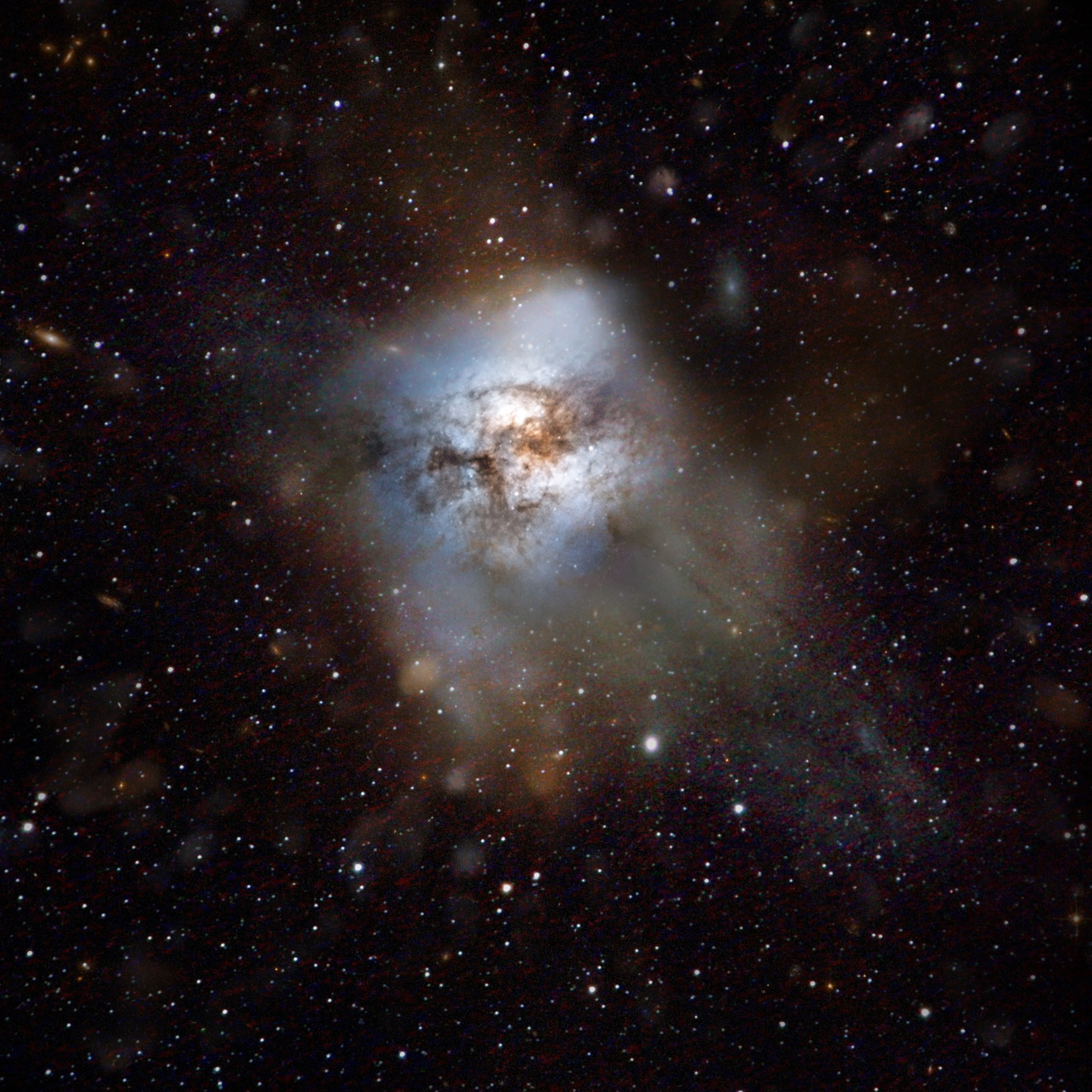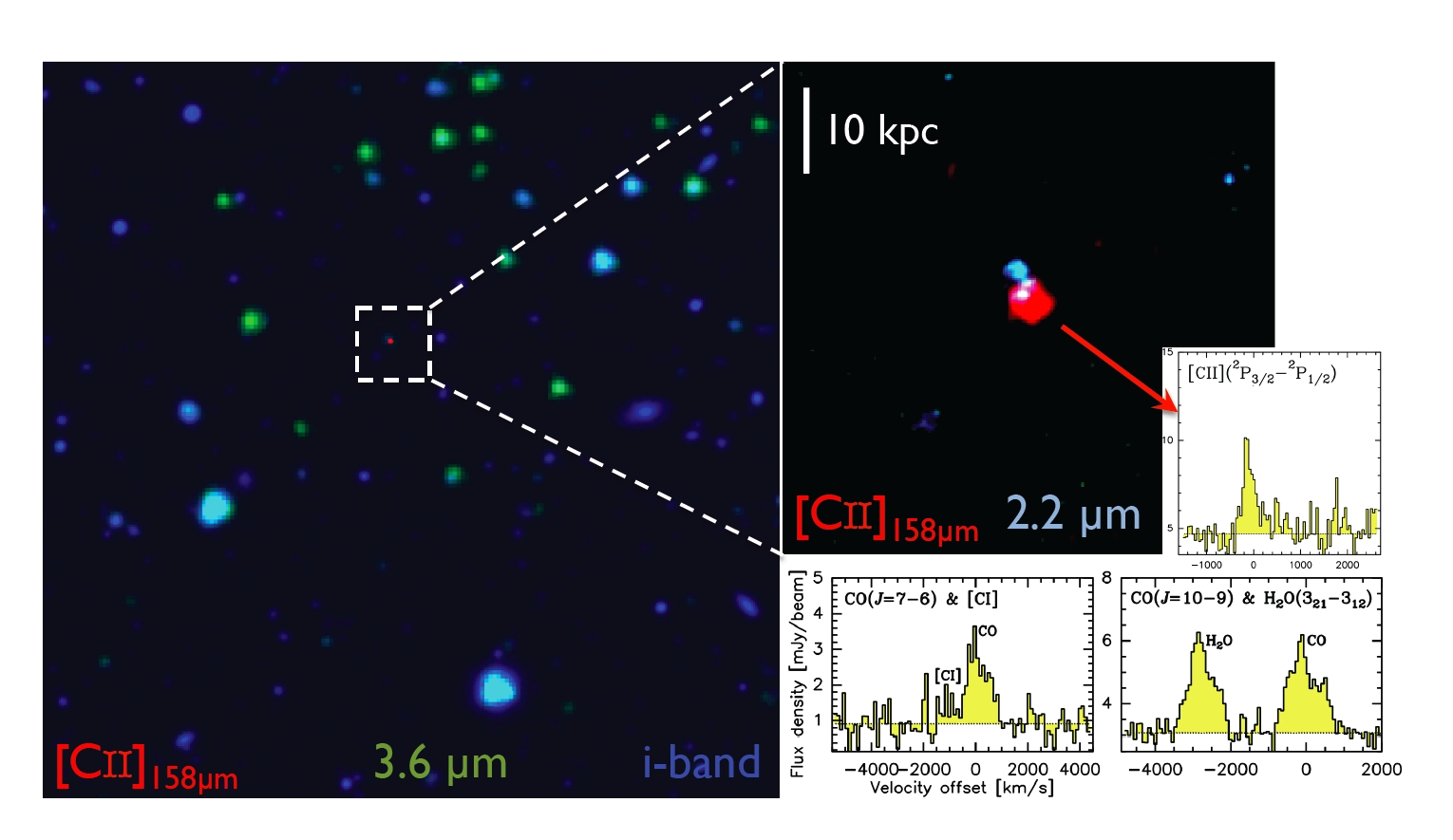News
Early star factory challenges galaxy evolution theory
Herschel has discovered a galaxy in the early universe making stars more than 2000 times faster than our own Milky Way. Located 28 billion light years from Earth, it is observed at a time when the Universe was less than a billion years old. Its mere existence challenges galaxy evolution theories.
The galaxy, known as HFLS3, appears as little more than a faint, red smudge on the Herschel Multi-tiered Extragalactic Survey (Hermes). Yet appearances can be deceiving, this smudge is a factory of star formation, furiously transforming its dust and gas into new stars. Whereas our own Milky Way makes little more than one star per year, HFLS3 churns out more than two thousand. Already close to the mass of the Milky Way, HFLS3 is likely to turn into one of the most massive galaxies seen today. The galaxy’s extreme distance means its light has travelled for almost 13 billion years across space before reaching us. As such, we see it as it existed in the infant Universe, just 880 million years after the Big Bang or at 6.5% of the Universe’s current age.
 |
| Starburst Galaxy, Credit : ESA-C. Carreau |
Even at that young age, HFLS3 was already close to the mass of the Milky Way, with roughly 140 billion times the mass of the Sun in the form of stars and star-forming material. After another 13 billion years, it should have grown to be as big as the most massive galaxies known in the local Universe. This makes the object an enigma. According to current theories of galaxy evolution, galaxies as massive as HFLS3 should not be present so soon after the Big Bang.
The first galaxies to form are expected to be relatively small and lightweight, containing only a few billion times the mass of our Sun. They form their first stars at rates of a few times that experienced by the Milky Way today. The small galaxies then grow by feeding off cold gas from intergalactic space and by merging with other small galaxies. So, finding the age at which the first massive galaxies appeared can constrain galaxy evolution theories. But this is not easy. “Looking for the first examples of these massive star factories is like searching for a needle in a haystack; the Herschel dataset is extremely rich,” says Dominik Riechers of Cornell University, who led the investigation.
Tens of thousands of massive, star-forming galaxies have been detected by Herschel as part of HerMES and sifting through them to find the most interesting ones is a challenge. "We were looking for the reddest galaxies as they are among the best probes to investigate star-formation as it was at play in the early Universe, and we found one which is among the most distant ever seen." says co-investigator Melanie Krips, IRAM. Red in this case means brightest at longer infrared wavelengths and, owing to the effect of redshift in our expanding Universe, this can indicate extreme distance.
 |
| HFLS3 was identified as a very high redshift candidate, as it appears red between the Herschel 250, 350, and 500μm bands. Wide-band spectroscopy with CARMA, the PdBI, the JVLA, and CSO/Z-spec uniquely determines its redshift to be z=6.3369. Four line profiles are shown in the three panels (bottom right) . Credit : D. Riechers, Cornell University |
The exceptional brightness of HFLS3 triggered a series of multi-wavelength follow-up observations with ground-based observatories. The CARMA interferometer was the first to determine its redshift but the most precise measurement was made with the IRAM interferometer which proved the presence of large reservoirs of molecular and ionized gas in HFLS3, as is typical for star-forming regions. "We detected several molecular and atomic species, among which various transitions of carbon monoxide (CO), water (H2O), the hydroxyl radical (OH), atomic (CI) and ionized carbon (CII). Altogether they allowed us to locate HFLS3 at a redshift of 6.34" said co-investigator Roberto Neri, IRAM. "These detections underline yet again the power of the IRAM interferometer and provide a flavor of what will be possible with the NOEMA interferometer in a few years from now. NOEMA will be one of the primary gateways to producing unbiased chemical surveys of the very first galaxies in the Universe."
With this in hand, the astronomers were able to confidently translate the galaxy’s infrared brightness into a star formation rate, discovering its extraordinary nature. HFLS3 is making so many stars that it is called a ‘maximum starburst’. The whole galaxy is wreathed in star formation, to the point where the intense radiation of the young stars almost blows away the star-forming material in the galaxy. "So bright that we were able to detect it in no time with the Goddard IRAM Superconducting two Millimeter Camera (GISMO) at the IRAM 30m telescope" said Carsten Kramer, IRAM. Environments like this do not exist on galaxy-wide scales in the Universe today. “Early starbursts like HFLS3 produced the heavy elements that made up later generations of stars and galaxies, and much of the matter we know today,” says Dominik Riechers. Even in the early Universe, they are expected to be extremely rare. The mere existence of a single such object so early in the Universe poses a challenge to current theories of early galaxy formation, which predict that they should reach such large masses only much later.The team are continuing to comb the enormous dataset from Herschel looking for more examples of such extreme, early galaxies.
Source(s):
A Dust-Obscured Massive Hyper-Starburst Galaxy at Redshift 6.34, Dominik A. Riechers et al., Nature, 18 avril 2013
For further information, please contact:
Roberto Neri, Melanie Krips IRAM Grenoble, France - Tel : 33(0)4 76 82 49 00
Email : neri@iram.fr ; krips@iram.fr
Dominik A. Riechers, Cornell University, New York - Tel: +1 626 395 4670
Email: riechers@astro.cornell.edu
IRAM Press contact : C. Berjaud - berjaud@iram.fr
CNRS Press Release :http://www.insu.cnrs.fr/node/4336

